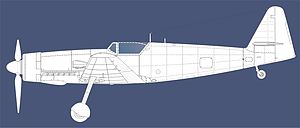Messerschmitt Me 209 (1943)
| Me 209 | |
|---|---|
 |
|
| Me 209 with DB 603 engine | |
| Role | Fighter prototype |
| Manufacturer | Messerschmitt |
| Designer | Willy Messerschmitt |
| First flight | 13 November 1943 |
| Retired | 1944 |
| Primary user | Luftwaffe (intended) |
| Number built | 4 |
The Me 209 of 1943 was an attempt to create an enhanced version of the Bf 109, which served as the Luftwaffe's primary fighter aircraft throughout World War II. The Me 209, despite its designation, bore no relationship to the earlier Me 209.
The RLM's 8-209 airframe number assigned to Messerschmitt, for its pair of post-July 1938 designation Me 209 airframes, was used for two projects during the late 1930s and early 1940s. The first Me 209 was a single-engine air speed record plane for which little consideration was given to adaptation for combat.
The second use of the Me 209 designation was for a proposal, in 1943, to make a heavily modified version of the Bf 109. This Me 209 would compete against Focke-Wulf's high performance Fw 190 D-9 and Ta 152 fighters. Like these enhanced versions of Kurt Tank's design, the new Me 209 would share most of its airframe with a proven model, in this case, the Bf 109G.
Unfortunately for the design team, the Me 209's proposed DB 603A engine was in short supply and they were forced to use the Junkers Motorenwerke firm's Jumo 213A engine. Even though the 35 litre engine displacement Jumo 213 had been deliberately designed to have as many of its engine access points as possible made to be identical with the 44.52 litre displacement DB 603 powerplant (Germany's largest-displacement inverted V12 aircraft engine), this changeover required some reconstruction of the engine cowling and cooling system. The most visible change was the required one to the engine's air intake location, as the Jumo 213's supercharger intake was located on the starboard side of the engine (as standard for all models of the earlier Junkers Jumo 211 inverted V12), versus the DB 603's portside location, the standard for all Daimler-Benz inverted V12 engine designs. The Me 209 featured a new tail section, wings, wide-track landing gear, a taller tail and an annular radiator for the inline engine, which gave the engine a superficial resemblance to a radial engine and to the very similar installation on the Focke-Wulf Fw 190D, which used the same Jumo 213 powerplant. The extent of the modifications undermined the original purpose, which was to build a superior aircraft as similar to the existing Bf 109G as possible.
...
Wikipedia
